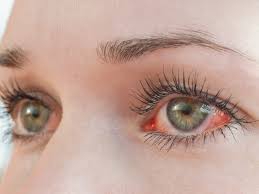Redness of the eyes, often referred to as bloodshot eyes, is a common condition where the whites of the eyes (sclera) appear red or pinkish. This occurs when the blood vessels on the surface of the eye become swollen or dilated. Eye redness can be caused by a wide range of factors, from benign irritations to serious medical conditions. Tropicamide Eye Drops and Ofloxacin Eye Drops are used to treat eye infections. Ofloxacin belongs to a class of drugs called quinolone antibiotics.
Understanding the causes and associated symptoms is essential for determining the appropriate treatment and knowing when to seek medical attention.
Common Causes of Eye Redness
- Irritants and Allergens:
- Environmental Factors: Smoke, dust, pollen, pet dander, and pollution can irritate the eyes, leading to redness. Prolonged exposure to these irritants often causes discomfort, itching, and watery eyes.
- Chemical Exposure: Contact with harsh chemicals like chlorine in swimming pools, household cleaning products, or even personal care products like shampoo can irritate the eyes, causing redness.
- Dry Eyes:
- Dry Eye Syndrome: When the eyes don’t produce enough tears or the tears evaporate too quickly, it can lead to dryness, which in turn causes redness, a gritty sensation, and discomfort. Prolonged screen time, air conditioning, and windy conditions can exacerbate dry eyes.
- Eye Infections:
- Conjunctivitis (Pink Eye): This is one of the most common causes of red eyes and can be viral, bacterial, or allergic in origin. Symptoms include redness, itching, discharge, and sometimes swelling of the eyelids.
- Blepharitis: Inflammation of the eyelids, often due to bacterial infection or skin conditions like dandruff, can cause red, itchy, and swollen eyes.
- Keratitis: Inflammation or infection of the cornea, often caused by bacteria, viruses, fungi, or parasites, can lead to redness, pain, blurred vision, and light sensitivity.
- Contact Lens Use:
- Improper Use: Wearing contact lenses for too long, sleeping with them in, or using dirty or damaged lenses can irritate the eyes, leading to redness, discomfort, and increased risk of infection.
- Allergic Reaction: Some individuals may develop an allergic reaction to the contact lens material or the cleaning solution, causing redness, itching, and discomfort.
- Injuries and Trauma:
- Physical Injury: Any direct injury to the eye, such as a scratch or foreign object, can cause redness, pain, and tearing.
- Subconjunctival Hemorrhage: This occurs when a small blood vessel breaks beneath the conjunctiva, the clear surface of the eye. It appears as a bright red or dark patch on the white of the eye and is usually painless, resolving on its own without treatment.
- Medical Conditions:
- Glaucoma: An increase in intraocular pressure can cause acute angle-closure glaucoma, a medical emergency characterized by severe eye pain, redness, blurred vision, halos around lights, and nausea.
- Uveitis: Inflammation of the uvea (the middle layer of the eye) can cause redness, pain, light sensitivity, and blurred vision. Uveitis requires prompt medical attention to prevent vision loss.
Associated Symptoms
- Pain or Discomfort: Eye pain, ranging from mild to severe, often accompanies redness, especially in cases of injury, infection, or glaucoma.
- Itching or Burning: Allergic reactions or irritants typically cause itching or burning sensations in the eyes.
- Discharge: Bacterial conjunctivitis and some other infections can cause yellow, green, or white discharge, often crusting on the eyelashes.
- Tearing or Watery Eyes: Excessive tearing can occur with allergies, dry eyes, or irritants.
- Blurred Vision: Conditions like keratitis, glaucoma, and uveitis can cause blurred vision along with redness.
- Light Sensitivity: Photophobia, or light sensitivity, is a common symptom in conditions like uveitis or keratitis.
When to Seek Medical Attention
While some causes of eye redness are minor and resolve on their own, others require medical intervention. Seek medical attention if you experience:
- Severe eye pain or a sudden change in vision.
- Persistent redness that does not improve.
- Sensitivity to light or significant eye discharge.
- Symptoms of glaucoma, such as halos around lights, nausea, and vomiting.
Conclusion
Eye redness can result from various causes, ranging from mild irritations to serious eye conditions. Recognizing the accompanying symptoms is crucial for determining the severity of the condition and whether medical attention is needed. If you are uncertain about the cause of eye redness or if symptoms persist, it is advisable to consult an eye care professional for an accurate diagnosis and appropriate treatment.
